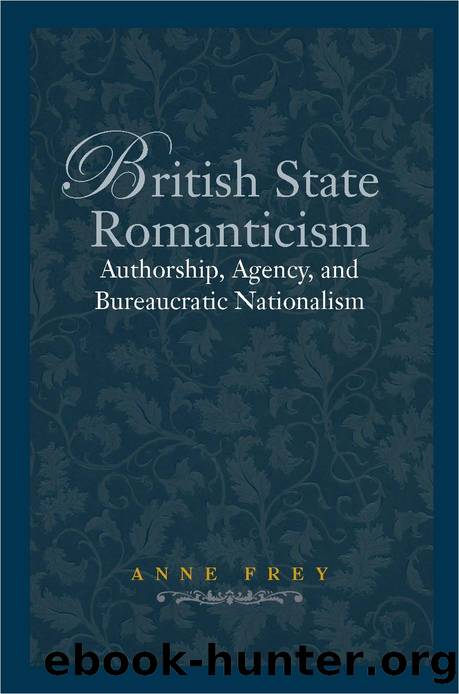British State Romanticism by Frey Anne;

Author:Frey, Anne;
Language: eng
Format: epub
Publisher: Stanford University Press
Published: 2011-08-10T00:00:00+00:00
Novels, Ballads, and Legal Authority
When Scott wrote and published The Heart of Midlothian in 1818, he had finally retired from poetry and switched completely to prose. In the 1830 Magnum Opus edition of his works, Scott offers two explanations for his turn to prose: first, as he aged, his powers of imagination were increasingly failing; second, and perhaps more to the point, his own prodigious sales were being eclipsed by Byron (Scottâs 1817 verse romance Harold the Dauntless sold poorly and confused readers, who compared Scottâs hero to the more famous and popular Childe Harolde), and he did not wish to compete. 35 The Heart of Midlothian, however, provides a different reason for Scottâs switch from poetry to prose: unlike the novel, the ballads and metrical romances cannot model modern forms of government agency.
Scott believes that in premodern times ballads played a version of the public role he seeks for novels. He follows the theory of ballad composition that attributes individual ballads to a single hand rather than to a collective process of creation and gradual revision. According to this theory, a bard or minstrel, often in service of a king, wrote each ballad, and the peasants merely transmitted them.36 Scottâs metrical romances depict bards and minstrels as figures of immense authority, advising kings and applying their knowledge of history and their sometimes magical ability to see into the future to predict the successes and failures of the dynasties they serve. Scott at times claims that his own role as poet likewise makes him an advisor to those in power; in Marmion, for example, the introductory letters to each canto counsel state leaders in the current Parliamentary era. In postunion Britain, however, poets are not counselors to the same degree. The closest position to the ancient bard would be the poet laureateâa position Scott declined in 1813âbut the laureateâs job is merely to celebrate the monarch and publicize British victories, not to advise. And if the metrical romances therefore do not grant Scott an advisory position, they also do not provide the opportunity to develop his account of the author as a pastoral state agent. The ballads and metrical romances do not depict agents who interpret across cultures. First, they portray a static era of cross-border conflict in which the fighting English and Scottish clans share a common border culture. 37 Second, they trust aristocrats and clan leaders to find the best policies for their people. Scottâs historical novels, in contrast, integrate a conflict between the present and past and between English and Scottish worldviews into the plot, and argue that citizen-agents best bridge these divides.
The Heart of Midlothian depicts the decline of the ballad. In part the bards have disappeared because the clans they served have been dismantled. Even more damningly, however, Scott portrays ballads as incompatible with the modern legal and social order. Ballads and bards have lost their authority, and to the extent that they have any power at all work in opposition to the state. The
Download
This site does not store any files on its server. We only index and link to content provided by other sites. Please contact the content providers to delete copyright contents if any and email us, we'll remove relevant links or contents immediately.
4 3 2 1: A Novel by Paul Auster(11791)
The handmaid's tale by Margaret Atwood(7450)
Giovanni's Room by James Baldwin(6810)
Asking the Right Questions: A Guide to Critical Thinking by M. Neil Browne & Stuart M. Keeley(5357)
Big Magic: Creative Living Beyond Fear by Elizabeth Gilbert(5353)
Ego Is the Enemy by Ryan Holiday(4958)
On Writing A Memoir of the Craft by Stephen King(4664)
The Body: A Guide for Occupants by Bill Bryson(4584)
Ken Follett - World without end by Ken Follett(4444)
Bluets by Maggie Nelson(4261)
Adulting by Kelly Williams Brown(4235)
Eat That Frog! by Brian Tracy(4149)
Guilty Pleasures by Laurell K Hamilton(4118)
White Noise - A Novel by Don DeLillo(3829)
The Poetry of Pablo Neruda by Pablo Neruda(3816)
Fingerprints of the Gods by Graham Hancock(3738)
Alive: The Story of the Andes Survivors by Piers Paul Read(3731)
The Book of Joy by Dalai Lama(3698)
The Bookshop by Penelope Fitzgerald(3619)
